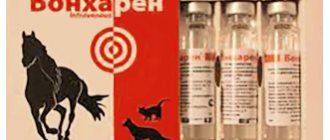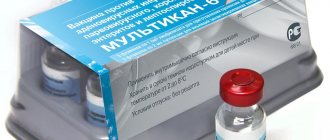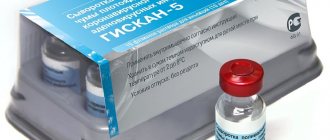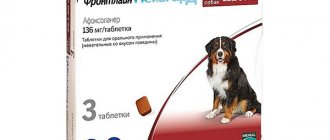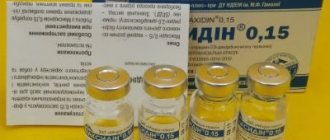Not all pet owners like to use conventional medications due to frequent side effects. In search of safe medications that would not affect the pet’s body, owners resort to homeopathic remedies. One of these is Veracol for dogs: it is prescribed for gastrointestinal disorders.
In this review I will look at how and why Veracol works, how effective it is, when and how to use it. At the end of the article you will find analogues of the medication and my opinion about the drug.
Compound
Veracol includes several components that together have a therapeutic effect on the dog’s body:
- white arsenic
- a toxic substance in minimal doses improves metabolism, destroys pathogenic microorganisms that cause gastrointestinal dysfunction; - white hellebore
– has an anti-inflammatory effect, eliminates spasms, normalizes intestinal function, relieves nausea and vomiting; - thyroid nogofoil
– has choleretic properties, restores the mucous membrane of the stomach and intestines; - bitter pumpkin – relieves pain and spasms, normalizes the functions of the liver and urinary organs.
Despite the fact that some components of Veracol are considered poisonous and dangerous, in homeopathic doses they are not capable of harming the animal’s body. Acting in combination, they eliminate inflammatory processes in the body caused by pathogenic bacteria.
Analogues of the drug
Verakol has no complete analogues in composition. There are also few drugs with similar effects. You can replace the drug with only two solutions:
| Analogue | What is the difference | average price |
| Liarsin | Also developed by Helvet. Contains moss seed, arsenicum album and phosphorus. Regulates the functioning of the gastrointestinal tract, normalizes protein, carbohydrate and fat metabolism. Often prescribed in combination with Veracol to enhance effectiveness. | Oral solution (20 ml) - 330 rubles; injection solution (10 ml) - 300 rub. |
| Nux Vomica-Homaccord | Developed in Germany. It contains the original substance Nux Vomica, enhanced by the homeopathic substance lycopodium, as well as herbal extracts of bryonia and colocynth. Prescribed for poisoning, disorders of the intestines, liver, kidneys, gallbladder and urinary system. | 620 rub. for 30 ml. |
Indications for use
Veracol is prescribed to animals with dysfunction of the digestive system. It promotes:
- rapid elimination of the inflammatory process;
- destruction of pathogenic bacteria, including staphylococci and streptococci;
- healing of wounds, ulcers in the stomach and intestines;
- restoration of mucous membranes;
- improving intestinal motility;
- relieving pain and spasms.
The medicine is prescribed for the treatment of helminthic infestations, various types of poisoning, and chronic pathologies of the gastrointestinal tract. It speeds up the rehabilitation process and quickly restores the balance of intestinal microflora. Due to the presence of all active ingredients in minimal quantities, the drug is not addictive.
The list of uses of Veracol is wide; it is used:
- for gastritis and gastroenteritis;
- dysbacteriosis;
- enteritis, enterocolitis;
- poisoning;
- colic and other diseases that are accompanied by indigestion.
conclusions
Veracol is used in veterinary medicine when they want to avoid the prescription of antibiotics and adsorbents - the main medications in the treatment of food poisoning. Adherents of the homeopathic drug claim that this approach reduces the negative impact of “chemical” agents on the animal’s body, does not provoke mutation of antibiotic-resistant strains of bacteria and microbes, and does not undermine the intestinal microflora.
Many veterinarians, breeders and dog owners speak really well of Veracola. They indicate that the drug works quickly, effectively and gently, without causing complications.
But I do not recommend resorting to any homeopathic remedy. The effectiveness of solutions containing, figuratively speaking, a drop of active ingredients per liter, is extremely doubtful. According to my observations, animals recover due to the use of other evidence-based medicine. And since homeopathy is often prescribed as a supplement, it is credited with having a “miracle effect.” Therefore, there is no need to torment your pet and waste money.
If your dog has gastrointestinal problems, go to the clinic for standard treatment. And Veracol or another homeopathic remedy, if you think it is effective, can be used in parallel: it will cause harm.
Dosage and method of administration
The dosage and method of use of the drug depend on its dosage form:
| Pills | Give 2-3 times a day for 5-10 days based on the weight of the animal. A single dose for puppies and dogs of small breeds is 1 tablet, medium breeds - 2 tablets, large dogs - 3. |
| Injections | Placed intramuscularly or subcutaneously in the following dosage: 0.1 ml per 1 kg of weight, twice or thrice a day |
| Drops | Prescribed 1 drop per 1 kg of weight, 2-3 times a day. |
Important! The veterinarian prescribes the medicine, taking into account the recommendations of the instructions for use, the characteristics of the course of the disease, the presence of symptoms and the patient’s condition.
Veracol 1 g sol. 3.5 ml 1% lidocaine solution No. 1 por.d/sol.d/in.vial.
Instructions for medical use of the drug Veracol TRADE NAME VERAKOL INTERNATIONAL NON-PROPENTED NAME CEFTRIAXONE DOSAGE FORM POWDER FOR PREPARATION OF SOLUTION FOR INJECTION, 1 G, COMPLETE WITH SOLVENT (1% SOLUTION OF LIDOCAINE HYDROCHLO READ FOR INJECTION, 3.5 ML). COMPOSITION ONE BOTTLE CONTAINS THE ACTIVE SUBSTANCE - CEFTRIAXONE SODIUM 1193.00 MG (EQUIVALENT TO CEFTRIAXONE 1000.00 MG). ONE AMPOULE WITH SOLVENT CONTAINS THE ACTIVE SUBSTANCE - LIDOCAINE HYDROCHLORIDE MONOHYDRATE 37.30 MG (EQUIVALENT TO LIDOCAINE HYDROCHLORIDE 35.00 MG), AUXILIARY SUBSTANCE - WATER FOR INJECTION UP TO 3.5 ML. DESCRIPTION OF THE PREPARATION: WHITE OR WHITE WITH A YELLOWSHIT POWDER, WITH A CHARACTERISTIC ODOR. SOLVENT: COLORLESS, TRANSPARENT LIQUID PHARMACOTHERAPEUTIC GROUP ANTIBACTERIAL DRUGS FOR SYSTEMIC USE. OTHER BETA-LACTAM ANTIBACTERIAL DRUGS. THIRD GENERATION CEPHALOSPORINS. CEFTRIAXONE. ATC CODE J01DD04 PHARMACOLOGICAL PROPERTIES PHARMACOKINETICS PHARMACOKINETICS OF CEFTRIAXONE IS NON-LINEAR. ALL MAIN PHARMACOKINETIC PARAMETERS BASED ON TOTAL DRUG CONCENTRATIONS, EXCEPT HALF-LIFE, ARE DEPENDENT ON THE DOSE AND INCREASE LESS THAN PROPORTIONALLY WITH ITS INCREASE. NONLINEARITY IS CHARACTERISTIC FOR PHARMACOKINETIC PARAMETERS DEPENDING ON THE TOTAL CONCENTRATION OF CEFTRIAXONE IN THE BLOOD PLASMA (NOT ONLY FREE CEFTRIAXONE) AND IS EXPLAINED BY THE SATURATION OF THE BINDING OF THE DRUG WITH BLOOD PLASMA PROTEINS. ABSORPTION AFTER INTRAVENOUS BOLUS ADMINISTRATION OF 500 MG AND 1 G CEFTRIAXONE, THE AVERAGE MAXIMUM CONCENTRATION IN BLOOD PLASMA WAS 120 MG/L AND 200 MG/L, RESPECTIVELY. AFTER INTRAVENOUS INFUSION OF 500 MG, 1 G AND 2 G CEFTRIAXONE, THE BLOOD PLASMA CONCENTRATIONS WERE APPROXIMATELY 80, 150 AND 250 MG/L, RESPECTIVELY. AFTER INTRAMUSCULAR INJECTION, THE VALUES OF THE AVERAGE MAXIMUM CONCENTRATION OF CEFTRIAXONE IN BLOOD PLASMA ARE ABOUT TWO TIMES LOWER THAN AFTER INTRAVENOUS ADMINISTRATION OF AN EQUIVALENT DOSE OF THE DRUG. THE MAXIMUM CONCENTRATION IN PLASMA AFTER A SINGLE INTRAMUSCULAR ADMINISTRATION OF 1 G OF THE DRUG IS ABOUT 81 MG/L AND IS ACHIEVED WITHIN 2-3 HOURS AFTER ADMINISTRATION. THE AREA UNDER THE PLASMA CONCENTRATION - TIME CURVE AFTER INTRAVENOUS AND INTRAMUSCULAR ADMINISTRATION IS THE SAME. DISTRIBUTION VOLUME OF DISTRIBUTION OF CEFTRIAXONE IS 7-12 L. CONCENTRATIONS ARE FAR ABOVE MINIMUM INHIBITORY CONCENTRATIONS FOR MOST INFECTIONS THAT MAY BE FOUND IN TISSUE, INCLUDING THE LUNGS , HEART, BALL TRACT, LIVER, TONSIL, MIDDLE EAR AND NASAL MUCOSA, BONES , AS WELL AS SPINAL, PLEURAL AND SYNOVIAL FLUID AND PROSTATE SECRET. An 8-15% INCREASE IN AVERAGE PEAK PLASMA CONCENTRATION (CMAX) IS OBSERVED WITH REPEATED ADMINISTRATION; STEADY STATE IS ACHIEVED IN MOST CASES WITHIN 48 - 72 HOURS DEPENDING ON THE METHOD OF ADMINISTRATION. PENETRATION INTO INDEPENDENT TISSUE CEFTRIAXONE PENETRATES THROUGH THE MINDING MEMBERS, TO THE GREATEST EXTENT WHEN THEY ARE INFLAMMATED. THE AVERAGE MAXIMUM CONCENTRATION OF CEFTRIAXONE IN THE CEREOSPINAL FLUID REACHES 25% OF THE PLASMA CONCENTRATION OF CEFTRIAXONE IN PATIENTS WITH BACTERIAL MENINGITIS, AND ONLY 2% OF THE PLASMA CONCENTRATION IN PATIENTS WITH NON-INFLAMMATORY THE MINING MEMBRANES. THE MAXIMUM CONCENTRATION OF CEFTRIAXONE IN THE CEREOSPINAL FLUID IS ACHIEVED 4-6 HOURS AFTER ITS INTRAVENOUS ADMINISTRATION. CEFTRIAXONE PASSES THROUGH THE PLACENTAL BARRIER AND EXISTS IN SMALL CONCENTRATIONS IN BREAST MILK. PROTEIN BINDING CEFTRIAXONE BINDS REVERSIBLY TO ALBUMIN. THE DEGREE OF BINDING IS APPROXIMATELY 95% AT CEFTRIAXONE CONCENTRATIONS IN BLOOD PLASMA LESS THAN 100 MG/L. THE PROPORTION OF CEFTRIAXONE BOUND TO BLOOD PLASMA PROTEIN DECREASES WITH ITS CONCENTRATION INCREASING, SINCE BINDING IS SATURABLE AND IS ABOUT 85% AT CONCENTRATION VALUES OF 300 MG/L. METABOLISM CEFTRIAXONE IS NOT SUBJECT TO SYSTEMIC METABOLISM, BUT IS CONVERTED INTO INACTIVE METABOLITES UNDER THE INFLUENCE OF INTESTINAL MICROFLORA. EXCLUSION TOTAL PLASMA CLEARANCE OF CEFTRIAXONE IS 10-22 ML/MIN. RENAL CLEARANCE IS 5-12 ML/MIN. 50-60% OF CEFTRIAXONE IS EXCRETED UNCHANGED IN THE URINE, AND 40-50% IS EXCRETED UNCHANGED IN BILE. THE HALF-LIFE OF CEFTRIAXONE IS ABOUT 8 HOURS IN ADULTS. PHARMACOKINETICS IN SPECIAL GROUPS OF PATIENTS IN PATIENTS WITH IMPAIRED RENAL OR LIVER FUNCTION THE PHARMACOKINETICS OF CEFTRIAXONE CHANGES SMALLLY, WITH ONLY A SMALL INCREASE IN THE HALF-LIFE (LESS THAN 2-fold) EVEN IN PATIENTS OB WITH SEVERE RENAL FAILURE. A SIGNIFICANT INCREASE IN THE HALF-LIFE OF CEFTRIAXONE IN RENAL FAILURE CAN BE EXPLAINED BY A COMPENSATORY INCREASE IN NON-RENAL CLEARANCE AS A RESULT OF A DECREASE IN THE DEGREE OF BINDING TO BLOOD PLASMA PROTEINS AND ACCORDINGLY A GENERAL INCREASE IN NON-RENAL CLEARANCE OF TOTAL CEFTRIAXONE. IN PATIENTS WITH LIVER FAILURE, THE HALF-LIFE IS NOT INCREASED. SUCH PATIENTS EXPERIENCE A COMPENSATORY INCREASE IN RENAL CLEARANCE. THE REASON IS ALSO AN INCREASE IN THE CONCENTRATION OF FREE CEFTRIAXONE IN THE BLOOD PLASMA, WHICH PROMOTES A PARADOXICAL INCREASE IN THE OVERALL CLEARANCE OF THE DRUG IN THE BACKGROUND OF AN INCREASE IN THE VOLUME OF DISTRIBUTION. PATIENTS OVER 75 YEARS OF AGE IN PERSONS OVER 75 YEARS OF AGE, THE HALF-LIFE OF CEFTRIAXONE IS EXTENDED ON AN AVERAGE BY TWO OR THREE TIMES. CHILDREN IN NEWBORN CHILDREN, THE HALF-LIFE OF CEFTRIAXONE IS INCREASED. IN THE FIRST 14 DAYS OF LIFE, THE CONCENTRATION OF FREE CEFTRIAXONE IN THE BLOOD PLASMA CAN BE ADDITIONALLY INCREASED DUE TO LOW glomerular FILTRATION AND THE PARTICULAR BINDING OF THE DRUG WITH BLOOD PLASMA PROTEINS. CHILD PATIENTS HAVE A SHORTER HALF-LIFE THAN INNATES AND ADULTS. PLASMA CLEARANCE AND VOLUME OF TOTAL CEFTRIAXONE CLEARANCE VALUES ARE HIGHER IN NEWBORNS, INFANTS AND CHILDREN UNDER 12 YEARS OF AGE COMPARED TO THOSE IN ADULTS. PHARMACOKINETIC/PHARMACODYNAMIC RELATIONSHIP AS WITH OTHER BETA-LACTAMS, THE PHARMACOKINETIC-PHARMACODYNAMIC INDEX SHOWING THE BEST CORRELATION WITH IN-VIVO EFFECTIVENESS IS A PERCENTAGE OF DOSING INTERVAL WHEN UNBOUND CONCENTRATION REMAINS ABOVE THE MINIMUM INHIBITORY CONCENTRATION (MIC) OF CEFTRIAXONE FOR SPECIFIC TARGET SPECIES (I.E. % T > MIC). PHARMACODYNAMICS THE BACTERICIDAL ACTIVITY OF CEFTRIAXONE IS DUE TO THE SUPPRESSION OF THE SYNTHESIS OF CELL MEMBRANES. IN VITRO CEFTRIAXONE HAS A WIDE SPECTRUM OF ACTION AGAINST GRAM NEGATIVE AND GRAM POSITIVE MICROORGANISMS. HIGHLY RESISTANT TO MOST β-LACTAMASES (BOTH PENICILLINASES AND CEPHALOSPORINASES) PRODUCED BY GRAM-POSITIVE AND GRAM-NEGATIVE BACTERIA. CEFTRIAXONE IS USUALLY ACTIVE AGAINST THE FOLLOWING MICROORGANISMS: GRAM POSITIVE AEROBES: STAPHYLOCOCCUS AUREUS (METHICILLIN SENSITIVE), STAPHYLOCOCCI COAGULASE-NEGATIVE, STREPTOCOCCUS PYOGENES (SS-HEMOLYTIC, GROUPS A), STREPTOCOCCUS AGALACTIAE (SS-HEMOLYTIC, GROUPS B), SS-HEMOLYTIC STREPTOCOCCUS (GROUPS NEITHER A, NOR B), STREPTOCOCCUS VIRIDANS, STREPTOCOCCUS PNEUMONIAE. NOTE. METHICILLIN-RESISTANT STAPHYLOCOCCUS SPP. RESISTANT TO CEPHALOSPORINS, INCLUDING CEFTRIAXONE. ENTEROCOCCUS FAECALIS, ENTEROCOCCUS FAECIUM AND LISTERIA MONOCYTOGENES ARE TYPICALLY RESISTANT. GRAM NEGATIVE AEROBES: ACINETOBACTER LWOFFI, ACINETOBACTER ANITRATUS (MAINLY A. BAUMANII)*, AEROMONAS HYDROPHILA, ALCALIGENES FAECALIS, ALCALIGENES ODORANS, ALCALIGENE-LIKE BACTERIA, BORRELIA BURGDORFERI, CAPNOCYTOP HAGA SPP., CITROBACTER DIVERSUS (INCLUDING C. AMALONATICUS), CITROBACTER FREUNDII*, ESCHERICHIA COLI, ENTEROBACTER AEROGENES*, ENTEROBACTER CLOACAE*, ENTEROBACTER SPP. (OTHER)*, HAEMOPHILUS DUCREYI, HAEMOPHILUS INFLUENZAE, HAEMOPHILUS PARAINFLUENZAE, HAFNIA ALVEI, KLEBSIELLA OXYTOCA, KLEBSIELLA PNEUMONIAE**, MORAXELLA CATARRHALIS (FORMERLY BRANHAMELLA CATARRHALIS), MORAXELLA OSLOENSIS, MOR AXELLA SPP. (OTHER), MORGANELLA MORGANII, NEISSERIA GONORRHOEA, NEISSERIA MENINGITIDIS, PASTEURELLA MULTOCIDA, PLESIOMONAS SHIGELLOIDES, PROTEUS MIRABILIS, PROTEUS PENNERI*, PROTEUS VULGARIS*, PSEUDOMONAS FLUORESCENS*, PSEUDOMONAS spp. (OTHER)*, PROVIDENTIA RETTGERI*, PROVIDENTIA SPP. (OTHER), SALMONELLA TYPHI, SALMONELLA SPP. (NONTYPHIDAL), SERRATIA MARCESCENS*, SERRATIA SPP. (OTHER)*, SHIGELLA SPP., VIBRIO SPP., YERSINIA ENTEROCOLITICA, YERSINIA SPP. (OTHER). * SOME ISOLATES OF THESE SPECIES ARE RESISTANT TO CEFTRIAXONE, MAINLY DUE TO THE FORMATION OF CHROMOSOME-ENCODED LACTAMASES. ** SOME ISOLATS OF THESE SPECIES ARE RESISTANT DUE TO THE FORMATION OF A NUMBER OF PLASMIDE-MEDIATED LACTAMASES. NOTE. MANY STRAINS OF THE ABOVE MICROORGANISMS, POLYRESISTANT TO OTHER ANTIBIOTICS, SUCH AS AMINOPENICILLINS AND UREIDOPENICILLINS, FIRST AND SECOND GENERATION CEPHALOSPORINS AND AMINOGLICOSIDES, ARE SENSITIVE TO CEFTRIAXONE . TREPONEMA PALLIDUM IS SENSITIVE TO CEFTRIAXONE IN VITRO AND IN ANIMAL EXPERIMENTS. CLINICAL TRIALS SHOW THAT CEFTRIAXONE HAS GOOD EFFECTIVENESS AGAINST PRIMARY AND SECONDARY SYPHILIS. WITH VERY MINOR EXCEPTIONS, CLINICAL ISOLETS OF P. AERUGINOSA ARE RESISTANT TO CEFTRIAXONE. ANAEROBES: BACTEROIDES SPP. (BILE SENSITIVE)*, CLOSTRIDIUM SPP. (EXCEPT C. DIFFICILE), FUSOBACTERIUM NUCLEATUM, FUSOBACTERIUM SPP. (OTHER), GAFFKIA ANAEROBICA (FORMERLY PEPTOCOCCUS), PEPTOSTREPTOCOCCUS spp. * SOME ISOLATES OF THESE SPECIES ARE RESISTANT TO CEFTRIAXONE DUE TO THE FORMATION OF B-LACTAMASES. NOTE. MANY STRAINS OF B-LACTAMASE-PRODUCING BACTEROIDES SPP. (IN PARTICULAR B. FRAGILIS) RESISTANT. RESISTANT AND CLOSTRIDIUM DIFFICILE. INDICATIONS FOR USE VERACOL IS PRESCRIBED FOR THE TREATMENT OF THE FOLLOWING INFECTIONS IN ADULTS AND CHILDREN, INCLUDING FULL-TERM INFANTS (FROM BIRTH): - BACTERIAL MENINGITIS - COMMUNITY-ACQUIRED PNEUMONIA - HOSPITALIZED PNEUMONIA - ACUTE MEDIA NIUM OTITIS - INTRA-ABDOMINAL INFECTION - COMPLICATED URINARY TRACT INFECTIONS (INCLUDING PYELONEPHRITIS) - INFECTIONS OF BONES AND JOINTS - COMPLICATED INFECTIONS OF SKIN AND SOFT TISSUE - GONORRHOEA - SYPHILIS - BACTERIAL ENDOCARDITIS - ACUTE EXACERBES OF CHRONIC OBSTRUCTIVE PULMONARY DISEASE IN ADULTS - DISSEMINATED LYME DISEASE (EARLY (STAGE II) AND LATE (STAGE III)) IN ADULTS AND CHILDREN, INCLUDING NEWBORN FROM 15 DAYS OF AGE - PREOPERATIVE PREVENTION OF SURGICAL INFECTIONS - NEUTROPEIA AND FEVER IN SUSPECTED BACTERIAL INFECTION - BACTEREMIA, WHICH ARISES IN CONNECTION WITH THE PRESENCE OR SUSPECTED Research Institutes FOR ANY OF THE INFECTIONS LISTED ABOVE, VERACOL IS ADMINISTERED TOGETHER WITH OTHER ANTIBACTERIAL MEDICINES WHEN THE POSSIBLE RANGE OF PATH CAUSING BACTERIA DOES NOT FALL INTO ITS SPECTRUM. OFFICIAL GUIDELINES REGARDING THE PROPER USE OF ANTIBACTERIALS SHOULD BE CONSIDERED. METHOD OF APPLICATION AND DOSES DOSES DEPEND ON THE TYPE, LOCATION AND SEVERITY OF INFECTION, SENSITIVITY OF THE PATIENT, AGE OF THE PATIENT AND THE CONDITION OF HIS LIVER AND KIDNEY FUNCTIONS. THE DOSES INDICATED IN THE TABLES BELOW ARE THE RECOMMENDED DOSES FOR USE FOR THESE INDICATIONS. IN ESPECIALLY SEVERE CASES, THE HIGHEST DOSE FROM THE RANGES SHOULD BE CONSIDERED. ADULTS AND CHILDREN OVER 12 YEARS OLD (BODY WEIGHT > 50 kg) CEFTRIAXONE DOSE * FREQUENCY OF APPLICATION** INDICATIONS 1-2 G 1 TIME A DAY NON-HOSPITAL PNEUMONIA. EXCERNSATION OF CHRONIC OBSTRUCTIVE PULMONARY DISEASES. INTRA-ABDOMINAL INFECTIONS. COMPLICATED URINARY TRACT INFECTIONS (INCLUDING PYELONEPHRITIS). 2G 1 TIME A DAY IN-HOSPITAL PNEUMONIA. COMPLICATED INFECTIONS OF SKIN AND SOFT TISSUE INFECTIONS OF BONES AND JOINTS. 2-4 G 1 TIME A DAY FOR PATIENTS WITH NEUTROPENIA AND FEVER CAUSED BY BACTERIAL INFECTION. BACTERIAL ENDOCARDITIS BACTERIAL MENINGITIS. *WHEN DEVELOPED BACTEREMIA THE HIGHEST DOSE FROM THE RANGE IS CONSIDERED. **WHEN PRESCRIBED IN A DOSE OF MORE THAN 2 G PER DAY (12 HOURS), THE POSSIBILITY OF USING THE DRUG 2 TIMES A DAY IS CONSIDERED. INDICATIONS FOR ADULTS AND CHILDREN OVER 12 YEARS OLD (>50 KG), WHICH REQUIRE A SPECIAL REGIME OF DRUG ADMINISTRATION: ACUTE OTITIS MEDIA AS A RULE, A SINGLE INTRAMUSCULAR ADMINISTRATION OF VERACOL IN A DOSE OF 1-2 G IS SUFFICIENT. EVIDENCE INDICATES THAT IN SEVERE CASES OR IF THERE IS NO EFFECT FROM PREVIOUS THERAPY, INTRAMUSCULAR ADMINISTRATION OF VERACOL IN A DOSE OF 1-2 G PER DAY FOR 3 DAYS MAY BE EFFECTIVE. PREOPERATIVE PREVENTION OF SURGICAL INFECTIONS SINGLE ADMINISTRATION BEFORE OPERATION IN A DOSE OF 2 G. GONORRHEA A SINGLE INTRAMUSCULAR ADMINISTRATION IN A DOSE OF 500 MG. SYPHILIS RECOMMENDED DOSES 500 MG OR 1 YEAR ONCE A DAY INCREASED TO 2 YEARS ONCE A DAY FOR NEUROSYPHILIS, DURATION OF TREATMENT 10-14 DAYS. DOSAGE RECOMMENDATIONS FOR SYPHILIS, INCLUDING NEUROSYPHILIS, ARE BASED ON LIMITED DATA. NATIONAL AND LOCAL GUIDELINES SHOULD BE CONSIDERED. DISSEMINATED LYME BORRELIOSIS (EARLY (II) AND LATE (III) STAGE) USE IN A DOSE OF 2 YEARS ONCE A DAY FOR 14-21 DAYS. THE RECOMMENDED DURATION OF TREATMENT VARIES AND NATIONAL AND LOCAL GUIDELINES SHOULD BE CONSIDERED. USE IN CHILDREN NEWBORN, INFANTS AND CHILDREN FROM 15 DAYS TO 12 YEARS OLD (<50 KG) CHILDREN WITH BODY WEIGHT OVER 50 KG OR MORE USUAL DOSES FOR ADULTS CEFTRIAXONE DOSE * FREQUENCY OF APPLICATION** INDICATIONS 50-80 M G/KG BODY WEIGHT 1 TIME A DAY INTRA-ABDOMINAL INFECTION. COMPLICATED URINARY TRACT INFECTIONS (INCLUDING PYELONEPHRITIS). NON-HOSPITAL PNEUMONIA. HOSPITALIZED PNEUMONIA. 50-100 MG/KG BODY WEIGHT (MAXIMUM DOSE - 4 G) 1 TIME A DAY FOR COMPLICATED INFECTIONS OF THE SKIN AND URINARY TRACT. INFECTIONS OF BONES AND JOINTS. NEUTROPENIAN PATIENTS WITH FEVER CAUSED BY BACTERIAL INFECTION. 80-100 MG/KG BODY WEIGHT (MAXIMUM DOSE - 4 G) 1 TIME A DAY BACTERIAL MENINGITIS. 100 MG/KG BODY WEIGHT (MAXIMUM DOSE - 4 G) 1 TIME A DAY BACTERIAL ENDOCARDITIS. *WHEN DEVELOPED BACTEREMIA THE HIGHEST DOSE FROM THE RANGE IS CONSIDERED. **WHEN PRESCRIBING A DOSE OF MORE THAN 2 G PER DAY (12 HOURS), THE POSSIBILITY OF USING THE DRUG 2 TIMES A DAY IS CONSIDERED. INDICATIONS FOR NEWBORNS, INFANTS AND CHILDREN FROM 15 DAYS TO 12 YEARS OLD (<50KG), WHICH REQUIRE A SPECIAL DRUG ADMINISTRATION REGIME: ACUTE OTITIS MEDIA AS A RULE, A SINGLE INTRAMUSCULAR ADMINISTRATION OF VERACOL IN D IS SUFFICIENT OSE 50 MG/KG BODY WEIGHT. LIMITED DATA SUGGEST THAT IN SEVERE CASES OR IN THE LACK OF EFFECT FROM PREVIOUS THERAPY, INTRAMUSCULAR ADMINISTRATION OF VERACOL AT A DOSE OF 50 MG/KG PER DAY FOR 3 DAYS MAY BE EFFECTIVE. PREOPERATIVE PREVENTION OF SURGICAL INFECTIONS SINGLE ADMINISTRATION BEFORE OPERATION IN A DOSE OF 50-80 MG/KG BODY WEIGHT. SYPHILIS RECOMMENDED DOSES 75-100 MG/KG BODY WEIGHT ONCE A DAY, TREATMENT DURATION 10-14 DAYS. DOSAGE RECOMMENDATIONS FOR SYPHILIS, INCLUDING NEUROSYPHILIS, ARE BASED ON LIMITED DATA. NATIONAL AND LOCAL GUIDELINES SHOULD BE CONSIDERED. DISSEMINATED LYME BORRELIOSIS (EARLY (P) AND LATE (III) STAGE) APPLY IN A DOSE OF 50-80 MG/KG BODY WEIGHT ONCE A DAY FOR 14-21 DAYS. RECOMMENDED TREATMENT DURATION VARIES. NATIONAL AND LOCAL GUIDELINES SHOULD BE CONSIDERED. INFANTS 0-14 DAYS OF AGE VERACOL IS CONTRAINDICATED IN PREMATURE INFANTS UNDER 41 WEEKS AGE (GESTATIONAL AGE + CHRONOLOGICAL AGE). CEFTRIAXONE DOSE * FREQUENCY OF APPLICATION** INDICATIONS 20-50 MG/KG BODY WEIGHT ONE TIME A DAY INTRA-ABDOMINAL INFECTIONS. COMPLICATED INFECTIONS OF SKIN AND SOFT TISSUE. COMPLICATED URINARY TRACT INFECTIONS (INCLUDING PYELONEPHRITIS). NON-HOSPITAL PNEUMONIA. HOSPITALIZED PNEUMONIA. INFECTIONS OF BONES AND JOINTS. PATIENTS WITH NEUTROPENIA AND FEVER CAUSED BY BACTERIAL INFECTION. 50 MG/KG BODY WEIGHT 1 TIME A DAY BACTERIAL MENINGITIS. BACTERIAL ENDOCARDITIS. *WHEN DEVELOPED BACTEREMIA THE HIGHEST DOSE FROM THE RANGE IS CONSIDERED. DO NOT EXCEED THE MAXIMUM DAILY DOSE OF 50 MG/KG BODY WEIGHT. INDICATIONS FOR NEWBORN AGED 0-14 DAYS, WHICH REQUIRE A SPECIAL REGIME OF DRUG ADMINISTRATION: ACUTE OTITIS MEDIA AS A RULE, A SINGLE INTRAMUSCULAR ADMINISTRATION OF VERACOL IN A DOSE OF 50 MG/KG BODY WEIGHT IS SUFFICIENT. PREOPERATIVE PREVENTION OF SURGICAL INFECTIONS. SINGLE ADMINISTRATION BEFORE OPERATION IN A DOSE OF 20-50 MG/KG BODY WEIGHT. SYPHILIS RECOMMENDED DOSE 50 MG/KG BODY WEIGHT ONCE A DAY, TREATMENT DURATION 10-14 DAYS. DOSAGE RECOMMENDATIONS FOR SYPHILIS, INCLUDING NEUROSYPHILIS, ARE BASED ON LIMITED DATA. NATIONAL AND LOCAL GUIDELINES SHOULD BE CONSIDERED. DURATION OF THERAPY THE DURATION OF THERAPY DEPENDS ON THE COURSE OF THE DISEASE. CEFTRIAXONE SHOULD BE CONTINUED FOR 48-72 HOURS AFTER THE PATIENT'S BODY TEMPERATURE IS NORMALIZED OR ERADICATION OF THE PATIENT IS CONFIRMED. USE IN ELDERLY PERSONS PROVIDING NORMAL FUNCTIONING OF THE KIDNEYS AND LIVER DOSE CORRECTION FOR ELDERLY PATIENTS IS NOT REQUIRED. USE IN PATIENTS WITH LIVER IMPAIRMENT AVAILABLE DATA DO NOT INDICATE THE NEED FOR CEFTRIAXONE DOSAGE ADJUSTMENT IN MIND OR MODERATE LIVER IMPAIRMENT IN THE CONDITION OF NORMAL RENAL FUNCTION. STUDIES ON THE USE OF THE DRUG IN PATIENTS WITH SEVERE LIVER FAILURE HAVE NOT BEEN CONDUCTED. The use in patients with impaired renal function does not indicate the need to correct the dose of ceftriaxone in patients with impaired renal function, provided that the liver function is not impaired. In cases of pre -rminal renal failure (creatinine clearance <10 ml/min), the dose of Ceftriaxone should not exceed 2 g per day. In patients in dialysis, additional administration of the drug after the procedure is not required. Ceftriaxone is not excreted by peritoneal hemodialysis. Clinical control over the safety and effectiveness of the drug is necessary. The use in patients with severe liver and renal failure in the use of ceftriaxon in patients with severe renal and liver failure, clinical control over the safety and effectiveness of the drug is necessary. The method of using a veracol should be used in the form of intravenous infusion for at least 30 minutes (preferred path), intravenously inkidly slowly for 5 minutes or deep injections intramuscularly. Intravenous jet administration should be carried out within 5 minutes preferably in large veins. Intravenous doses of 50 mg/kg or more in babies and children under 12 years of age should be administered by infusion. In newborns, the duration of infusion should be more than 60 minutes to reduce the potential risk of bilirubin encephalopathy. Intramuscular administration should be carried out into large muscles, in one muscle to introduce no more than 1 g. Ceftriaxone should be administered intramuscularly in cases when it is not possible to administer the drug intravenously or the intramuscular path of administration is preferable to the patient. For doses exceeding 2 g, the intravenous method of administration should be used. For preoperative prevention of surgical infections, ceftriaxone should be administered 30-90 minutes before surgery. The introduction of a general rule should be the use of solutions immediately after cooking. The prepared solutions retain their physical and chemical stability for 6 hours at room temperature (or for 24 hours at a temperature of 2-8 ºC). Depending on the concentration and duration of storage, the color of solutions can vary from pale yellow to amber. The color of the solution does not affect the effectiveness or tolerance of the drug. For intramuscular injection, 1 g of the drug, the veracol is dissolved in a 3.5 ml of a 1% solution of lidocaine and introduced deep into a sufficiently large muscle (buttock). It is recommended to introduce no more than 1 g into the same muscle. Lidocaine is not used as a solvent in pediatric practice. A solution containing lidocaine cannot be administered intravenously. The solutions of the drug veracol cannot be mixed or added to solutions containing other antimicrobial drugs or other solvents, due to possible incompatibility. Due to the risk of sedimentation for the dissolution of ceftriaxone, calcium-containing drugs (Ringer's solution, Hartmann solution) should not be used. Also, the occurrence of precipitates of calcium salts of ceftriaxon can occur when mixing the drug with solutions containing calcium in one infusion system for intravenous administration. Therefore, do not mix or simultaneously use ceftriaxone and solutions containing calcium. Side effects often (> 1/100, <1/10) - eosinophilia, leukopenia, thrombocytopenia - diarrhea, unformed stool - an increase in the levels of liver enzymes - rash infrequently (> 1/1000, <1/100) - fungal infections of the genitals - Granulocytopenia, anemia, coagulation disorders - headache, dizziness - nausea, vomiting - itching - phlebitis, pain in the injection site, fever - increasing the level of creatinine in the blood rarely (> 1/10 000, <1/1000) - pseudo -dimeembranous colitis - bronchospasm - urticaria - hematuria, glucosuria - swelling, chills, frequency is unknown - superinfection - hemolytic anemia, agranulocytosis - anaphylactic shock, anaphylactic reactions, anaphylactoid reactions, hypersensitivity - cramps - vertigo - pancreatitis, stomatitis - gbossia - preacty of Ceftrianson calcium salts in the gallstones. Derenaya Jaundice - Stevens - Johnson syndrome, toxic epidermal necrolysis, multiforme erythema, acute generalized exanthematous pustulais - oliguria, the formation of precipitates in the kidneys (reversible) - false positive results, analysis of galactocurium, non -enzyntic methods for determining contraindication glucose - increased sensitivity to antibiotics Cephalosporinov, to the group of beta-lactam antibiotics (penicillins, monobactam and carbapenema), lidocaine or any of the auxiliary substances-hyperbilirubinemia in newborns and premature babies (ceftriaxone can supplant bilirubin from serum albumin, increasing the risk of developing bilirubinic encephalopathies in such patients)-age) Art Premature babies ≤ 41 weeks, taking into account the term of intrauterine development (gestational age + age after birth) - newborns (≤28 days), with jaundice, hypoalbuminemia or acidosis, because bilirubin binding is violated (≤28 days), if necessary (or necessary Expected necessity) treatment with intravenous calcium -containing solutions, including intravenous calcium -containing infusions, such as parenteral nutrition, due to the risk of formation of precipitates of Ceftriaxon calcium salts, which is already prescribed - intravenous administration of ceftriaxon solutions containing lidocaine. Medicinal interactions solvent containing calcium, such as a solution of a Ringer or a solution of gartman, should not be used to restore a veracol in bottles or for further dilution of a restored solution for intravenous administration, as a precipitation may form. Calcium salts of Ceftriaxone can also form when confrontriaxone mixing with calcium -containing solutions in one infusion system. Ceftriaxone cannot be administered simultaneously with intravenous administration solutions containing calcium, including calcium-containing solutions for prolonged infusion, such as parenteral nutrition solutions using the Y-shaped system. However, all patients, except for newborns, ceftriaxone and calcium -containing solutions can be administered sequentially, after each other, if the system is thoroughly rinsed between the infusion of the compatible liquid. In vitro using the umbilical blood plasma of adults and newborns, it was shown that the newborn threatens the increased risk of the formation of precipitates of Calcium salt of Ceftriaxone. The simultaneous use of the drug with oral anticoagulants can enhance the effect against vitamin K and the risk of bleeding. It is recommended to often check the international normalized attitude and properly adjust the dose of antivitamin K both during and after therapy with ceftriaxone. Ceftriaxone is pharmaceutically incompatible with amsacrine, vanc -breeding, fluconazole and aminoglycosides. In vitro, antagonism was discovered between chloramphenicol and ceftriaxone. In patients who use ceftriaxone, false positive results are possible: the cumbs test, analysis of galactos and non -enzyme methods for determining glucose while using large doses of veracol and “loop” diuretics (for example, fusemine), and renal function of the kidney function was not observed. Probenecide does not affect the excretion of the drug Verakol. The use of alcohol after the introduction of the drug Verakol was not accompanied by a disulfiram -like reaction. Ceftriaxone does not contain a N-methyliteal group that could cause intolerance to ethanol and bleeding, which is inherent in some other cephalosporins. Bacteriostatic antibiotics reduce the bactericidal effect of ceftriaxone. Special instructions of the drug are used only in a hospital. Hypersensitivity reactions when using a veracol should take into account the probability of developing anaphylactic shock. In the case of its development, adrenaline, and then glucocorticoid agents should be introduced immediately. As with all beta-lactam antibiotics, cases of serious hypersensitivity reactions were reported, sometimes with death. In the case of severe hypersensitivity reactions, the use of ceftriaxon should immediately stop and take appropriate emergency measures. Before starting treatment, it should be established whether the patient has a history of severe hypersensitivity reactions to Ceftriaxone, other cephalosporins or other types of beta-lactam agents. Cares should be used in patients with a history of mild hypersensitivity to other beta-lactam preparations. Cases of severe adverse reactions from the skin (Stevens - Johnson or Lyell syndrome/toxic epidermal necrolysis) have been recorded, but the frequency of these phenomena is unknown. Interaction with drugs containing calcium in premature and full -term babies under the age of 1 month describes cases of the formation of precipitates of Calcium salt of ceftriaxone in lungs and kidneys with death. At least one of these patients Ceftriaxone and calcium was introduced at different times and according to different in/in infusion systems. According to the available scientific data, confirmed cases of the formation of intravascular precipitates are not registered, except in newborns, which were introduced by ceftriaxone and calcium -containing solutions or any other calcium -containing drugs. In vitro it is shown that newborns are facing an increased risk of the formation of precipitates of Calcium salt of Ceftriaxon compared to patients of other age groups. When using ceftriaxon in patients of any age, the drug cannot be mixed or administered simultaneously with any solutions for intravenous administration containing calcium, even when using various infusion systems or the administration of drugs into various infusion areas. However, patients over the age of 28 days of ceftriaxone and calcium -containing solutions can be administered sequentially, after each other, provided that the drugs are administered through various infusion systems in different parts of the body or replacement or thoroughly washing the infusion system between the introduction of these drugs with a physiological saline to prevent the formation of a precipal . Patients who need constant infusions of calcium -containing solutions for complete parenteral nutrition (PPP) can prescribe alternative antibacterial agents, the use of which is not associated with a similar risk of precipitates. If the use of ceftriaxone in patients who need constant nutrition is recognized as necessary, solutions for PPP and ceftriaxone can be administered simultaneously, although according to various infusion systems and in different parts of the body. Also, the administration of solutions for the PPP can be suspended during the infusion of ceftriaxone and rinse the infusion systems between the introduction of solutions. Immuno -mediated hemolytic anemia cases of immuno -mediated hemolytic anemia were detected in patients who received antibacterial agents of the cephalosporin class, including a veracol. Severe cases of hemolytic anemia, including death, are registered during the treatment of Ceftriaxone both in adults and in children. If an anemia occurs during the use of ceftriaxon, an anemia associated with the use of cephalosporin should be considered, and stop the use of ceftriaxone until the etiology of the disease is established. Pseudomembranous colitis describes very rare cases of pseudomembranous colitis (<0.01%) and blood coagulation disorders, as well as the formation of calculi in the kidneys, mainly in children over 3 years old, receiving either large daily doses of the drug (more than 80 mg/kg per day), Or cumulative doses of more than 10 g, as well as additional risk factors (limiting fluid intake, bed rest, etc.). The formation of concrete in the kidneys can be asymptomatic or manifested clinically, can lead to renal failure. This undesirable phenomenon is reversible and disappears after the termination of therapy with ceftriaxone. Sodium each gram of a daily contains 3.6 sodium mmol. This should be taken into account for patients who adhere to diets with controlled sodium content. The spectrum of antibacterial activity Ceftriaxone has a limited spectrum of antibacterial activity and can be unsuitable for use as monotherapy in the treatment of certain types of infection, except when the pathogen has already been confirmed. In the case of polymicrobial infections, when there are microorganisms that are resistant to the ceftriaxone, the use of additional antibiotics should be considered among suspected pathogens. CHOLELITHIASIS
Limitations and side effects
The only prohibition on taking the medicine is individual intolerance to the components. Therefore, for the first time, Veracol is given to animals under the supervision of a doctor - this will make it possible to provide medical assistance in a timely manner.
The medicine also has no side effects; on the forums of veterinarians and dog owners there is no information about complications after taking Veracol. The highly effective drug is safe for the liver and other organs and systems of the animal. It can be given to puppies and weakened animals for which there is a ban on taking antibiotics.
Description of the drug Veracol for dogs
Veracol is a homeopathic remedy for dogs suffering from digestive disorders. Prescribed for the treatment of diseases of the gastrointestinal tract (gastritis, gastroenteritis, intestinal dysbiosis, etc.) and infectious etiology.
Active substances
Veracol contains white arsenic, white hellebore, thyroid gourd, and bitter gourd. These components have been used to treat gastrointestinal disorders for centuries. The complex product has an anti-inflammatory effect and helps restore the functional capacity of the gastrointestinal tract.
Release form
The drug is available in the form of a solution for oral administration, in the form of tablets and in the form of a solution for injection. The tablets are packaged in 50 pieces in polymer packaging. The solution for injection is a clear, colorless liquid (10 ml and 100 ml in glass vials). The solution for oral use is packaged in 20 ml plastic bottles with droppers.
Reviews
Veterinarians
Taisiya, veterinarian, 45 years old: “I often prescribe Veracol to small kittens and old animals, because it has no contraindications or side effects. The drug is good, you can choose a convenient form of administration. The effect appears almost immediately.”
Sergey, veterinarian, 50 years old:
“Veracol is an excellent drug, although homeopathic remedies are not as popular here as in Europe. I prescribe it both in the complex treatment of pathologies of the digestive system and in monotherapy. The owners are happy because... it reduces the treatment period by half and is suitable for animals of any age and condition.”
Owners
Olga, 23 years old, Saratov:
“I picked up a kitten on the street. He looked to be only 1-1.5 months old. He had persistent diarrhea and was not eating well. He was thin and weak. The doctor advised me to give Veracol in drops. On the 2nd day, the diarrhea disappeared, and the kitten began to eat with appetite.”
Tatyana, 19 years old, Astana: “The cat lost her appetite, she began to lose weight and lie down more. The doctor diagnosed enteritis. They gave it to Verakol and Liarsin. Both remedies are homeopathic. The cat recovered quickly."
Maxim 42 years old, Kazan:
“I don’t believe in all herbal medicines and homeopathy, but when the doctor prescribed Veracol for my cat Ugolyk, I decided to try it. The medicine helped and put Coal on his feet within a week, although before that they had been treated for a long time and to no avail.”
Can it be used?
The main indications for the use of Veracol are:
- inflammatory and infectious pathologies of the gastrointestinal tract;
- parasitic infections, incl. helminthiasis;
- acute digestive and stool disorders;
- poisoning;
- vomit;
- violation of motor function of the gastrointestinal tract;
- spasms and colic.
Pathological changes developing in the digestive system lead to diseases of other internal organs and manifest themselves externally - in animals, the fur becomes dull, thins and falls out, and dermatological pathologies arise. Veracol eliminates the symptoms, causes and complications of diseases of the gastrointestinal tract and hepatobiliary system in cats.
The medicine has the following properties:
- antispasmodic;
- antibacterial;
- antiparasitic;
- anti-inflammatory;
- immunological;
- regenerative;
- hepatoprotective;
- choleretic;
- laxative.
Interaction with other drugs
The use of Veracol can and should be combined with the use of other drugs:
- homeopathic;
- antibacterial;
- detoxification;
- immunocorrective;
- symptomatic, etc.
The effect of using Veracol will be stronger if used as part of complex therapy
